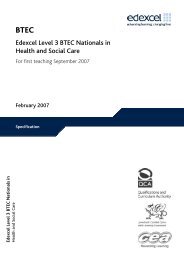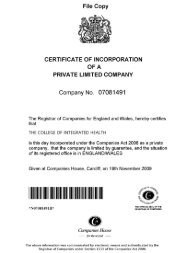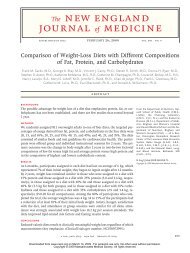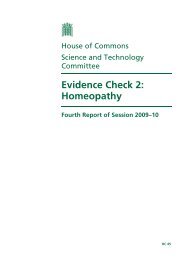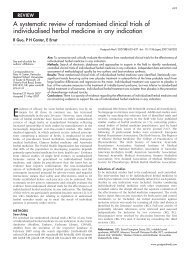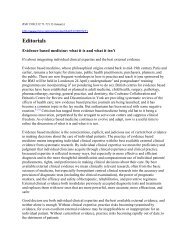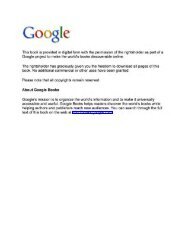German Acupuncture Trials (GERAC) for Chronic Low Back Pain
German Acupuncture Trials (GERAC) for Chronic Low Back Pain
German Acupuncture Trials (GERAC) for Chronic Low Back Pain
You also want an ePaper? Increase the reach of your titles
YUMPU automatically turns print PDFs into web optimized ePapers that Google loves.
Table 2. Baseline Characteristics in 1162 Patients Randomized and 640 Patients Screened-Only a<br />
Baseline Characteristic<br />
Verum <strong>Acupuncture</strong><br />
(n = 387)<br />
were not included in a secondary sensitivity analysis,<br />
thereby statistically favoring the conventional therapy.<br />
This reduced the therapy effect in the response rates between<br />
acupuncture and conventional therapy by less than<br />
1%. Overall, the primary results remain stable. Balanced<br />
randomization ensured that there were no relevant differences<br />
between the 3 treatment groups insofar as the<br />
5 potentially prognostic factors (Table 2).<br />
TREATMENTS AND BLINDING<br />
A total of 13 475 treatment sessions were conducted<br />
(verum acupuncture, 4821 [mean, 12.5 per patient]; sham<br />
acupuncture, 4590 [mean, 11.9 per patient]; conventional<br />
therapy, 4064 [mean, 10.5 per patient]). Mean±SD<br />
treatment time per session was 30.5±2.5 minutes in all<br />
groups. The number of patients who received the 5 additional<br />
sessions was 232 (59.9%) in the verum group,<br />
209 (54.3%) in the sham group, and 192 (52.5%) in the<br />
conventional group. The therapies given in the conventional<br />
group were physiotherapy (n=197; mean, 11.7 sessions<br />
per patient), massage (n=180; mean, 9.5 sessions<br />
per patient), heat therapy (n=157; mean, 9.7 sessions per<br />
patient), electrotherapy (n=65; mean, 8.8 sessions per<br />
patient), back school (ie, a practical education in the management<br />
of back pain) (n=36; mean, 8.1 sessions per patient),<br />
injections (n=48; mean, 5.6 per patient), and guidance<br />
(n=56; mean, 4.2 sessions per patient). In a few<br />
patients, therapies included infusions, yoga, hydrojet treatment,<br />
and swimming. Pharmacologic treatment in the<br />
conventional therapy group consisted of analgesics in 95%<br />
of patients (n=183; mean, 16.2 per patient). At the end<br />
of the study, patients rated the credibility of both acupuncture<br />
<strong>for</strong>ms positively. Blinding seems to have been<br />
maintained: most patients did not correctly identify or<br />
did not know which <strong>for</strong>m they had received (Table 3).<br />
Primary outcome at 6 months could be assessed in 96.1%<br />
Sham <strong>Acupuncture</strong><br />
(n = 387)<br />
Standard Therapy<br />
(n = 388)<br />
(1117 patients [377 received verum; 376 sham, and 364<br />
standard treatment]) of all randomized patients.<br />
CLINICAL OUTCOMES<br />
Screened Only<br />
(n = 640)<br />
Sex, No.(%)<br />
Men 165 (42.6) 140 (36.2) 165 (42.5) 267 (41.7)<br />
Women 222 (57.4) 247 (63.8) 223 (57.5) 373 (58.3)<br />
Age, y 49.6 ± 14.6 (380) 49.2 ± 14.8 (382) 51.3 ± 14.5 (381) 48.5 ± 14.7 (619)<br />
Body mass index b 26.9 ± 4.7 (381) 26.5 ± 4.8 (378) 26.3 ± 4.5 (378) 26.1 ± 4.4 (614)<br />
Prognostic factors<br />
History of back pain, y 8.1 ± 7.7 (380) 7.7 ± 8.2 (382) 8.1 ± 8.3 (380) 7.6 ± 7.6 (617)<br />
Patient expectations c 7.6 ± 1.7 (387) 7.7 ± 1.8 (387) 7.7 ± 1.8 (388) 7.4 ± 1.9 (512)<br />
Fear avoidance beliefs d 3.3 ± 1.3 (387) 3.2 ± 1.3 (387) 3.3 ± 1.3 (388) 3.6 ± 1.2 (54)<br />
Physical activity, c min/d 70.5 ± 121.5 (377) 67.1 ± 119.3 (347) 67.5 ± 117.4 (381) 48.8 ± 106.9 (54)<br />
<strong>Pain</strong>, CPGS 67.7 ± 13.9 67.8 ± 13.2 67.8 ± 14.6 NA<br />
Disability, HFAQ 46.3 ± 14.7 46.3 ± 15.3 46.7 ± 14.5 NA<br />
Quality of life, SF-12 NA<br />
Physical component summary 31.8 ± 6.8 31.5 ± 6.9 31.6 ± 6.8<br />
Mental component summary 46.6 ± 12.3 46.6 ± 11.5 47.1 ± 11.6<br />
Abbreviations: GCPS, Von Korff <strong>Chronic</strong> <strong>Pain</strong> Grade Scale (low values better); HFAQ, Hanover Functional Ability Questionnaire (high values better); NA, not<br />
available; SF-12, 12-item Short-Form Health Survey (high values better).<br />
a Data are given as mean ± SD (number of patients) unless otherwise indicated.<br />
b Calculated as weight in kilograms divided by height in meters squared.<br />
c Not at all helpful, 0; extremely helpful, 10.<br />
d Beliefs about back pain caused by physical activity: not at all, 0; absolutely true, 6.<br />
Table 3. Assessment of Patient Blinding at End of Study a<br />
Type of<br />
<strong>Acupuncture</strong><br />
Received<br />
Verum<br />
(specific)<br />
Sham<br />
(nonspecific)<br />
Type of<br />
<strong>Acupuncture</strong><br />
Patients Stated<br />
They Had<br />
Received<br />
Level of Confidence<br />
of Patient Answers<br />
Certain Uncertain<br />
Total<br />
Specific 45 (42.5) 61 (57.5) 106 (28.1)<br />
Nonspecific 48 (44.0) 61 (56.0) 109 (28.9)<br />
Don’t know 126 (33.4)<br />
Missing 36 (9.5)<br />
377<br />
Specific 26 (30.2) 60 (69.8) 86 (22.9)<br />
Nonspecific 49 (39.5) 75 (60.5) 124 (33.0)<br />
Don’t know 141 (37.5)<br />
Missing 25 (6.6)<br />
376<br />
a Data are given as number (percentage).<br />
Table 4 gives the response rates and between-group differences<br />
at 6 months. Almost half of patients in the acupuncture<br />
groups but only one-fourth of patients in the<br />
conventional therapy group benefited. Because the P value<br />
of the comparison of verum acupuncture and conventional<br />
therapy is �2.5% and the P value of the comparison<br />
of sham acupuncture and conventional therapy is<br />
�5.0%, both differences are statistically significant according<br />
to the closed testing procedure.<br />
Verum acupuncture was not superior to sham acupuncture,<br />
with an observed difference of 3.4% (P=.39). Be<strong>for</strong>e<br />
applicationofthenonrespondercriterion,successrateswere<br />
about 30% greater; that is, in any group, about 25% of pa-<br />
(REPRINTED) ARCH INTERN MED/ VOL 167 (NO. 17), SEP 24, 2007 WWW.ARCHINTERNMED.COM<br />
1895<br />
Downloaded from<br />
www.archinternmed.com at University College London, on September 25, 2007<br />
©2007 American Medical Association. All rights reserved.



